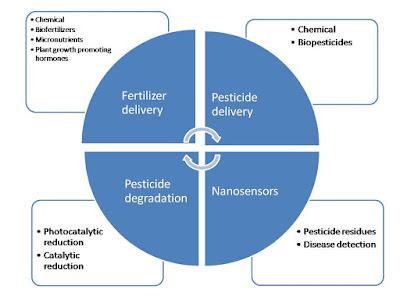Nanotechnology in Agriculture
The use of nanomaterials for delivery of pesticides
and fertilizers is explored to reduce the dosage and ensure controlled slow
delivery but the risk assessment of the use of nanomaterials is still not
defined. Toxicity of the ecosystem, potential residue carry-over in foodstuff
and nanomaterials phytotoxicity are some of the major concern for application
of nanomaterials in agriculture. The health concern of nanomaterials has been reviewed . There is need to evaluate the
toxicokinetics and toxicodynamics of nanomaterials used in agricultural
production. Nanomaterials owing to increased surface area might have toxic effects
that are not apparent in the bulk materials especially in open agricultural
ecosystem. The selection of nanomaterials for application in the field may
be critical as materials which are non-toxic, biodegradable and biocompatible
are desirable. Nanofabrication with hyper-accumulator plant or in combination
with soil microorganism will provide the approach of “Designer plant” boosting
up the nutrient uptake and phytomining efficiency. This can be achieved in future by
nano-biofarming or particle farming. This is one such field which yields
nanoparticles for industrial use by growing plants in defined soil.
Smart precision farming will make use of computers,
global satellite positioning system and remote sensing devices to measure
highly localized environmental conditions enabling us to know whether crops are
growing at maximum efficiency. Nanotechnology may be developed and deployed for
real-time monitoring of the crop growth and field conditions including moisture
level, soil fertility, temperature, crop nutrient status, insects, plant
diseases, weeds. Networks of wireless nanosensors positioned across cultivated
fields will provide essential data leading to best agronomic intelligence
processes with the aim to minimize resource inputs and maximize output.
Humidity, light temperature, soil conditions,
fertilization, insects, and plant diseases all affect the release of volatile
organic compounds which could be detected by electronic nose. Electronic noses
in agriculture will detect crop diseases, identify insect infestation, and
monitor food quality. The electronic nose could also be used in food industry
to assess the freshness spoilage of fruits and vegetables during the processing
and packaging process. Smart dust technology will be used for monitoring
various parameters such as temperature, humidity, insect and disease
infestation in future. This is the future of agriculture, an army of
nanosensors will be scattered like dust across the farms and fields, working
like the eyes, ears and nosed of the farming world. These tiny wireless sensors
are capable to communicate the information they sense. These will be programmed
and designed to respond various parameters like variation in temperature,
nutrients and humidity.
In summary, the development of nanomaterials with
good dispersion and wettability, biodegradable in soil, and environment, less
toxic and more photo-generative, with well understood toxicokinetics and
toxicodynamics, smart and stable, and ease of fabrication and application in
agriculture, would be ideal for their effective use in agricultural crop production.



No comments:
Post a Comment